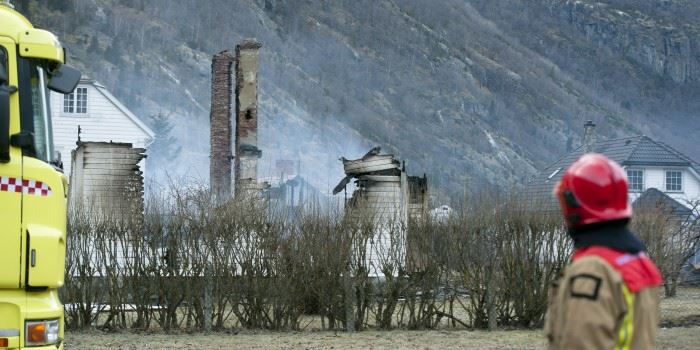Two days after the catastrophic fire in Lærdal in Western Norway, which destroyed 40 buildings, an eleven-year-old report from SINTEF NBL, the Norwegian Fire Research Laboratory, once again became highly relevant.
When fire crews obtained permission to set fire to an old timber house beside the new E6 highway in Melhus in the County of Sør-Trøndelag, then under construction, SINTEF’s fire researchers were given the chance to test the effects of a water-mist system that they had installed in the loft.
“We found that the water-mist kept the temperature in the loft fairly low for a reasonable length of time, in fact well below 100 oC, and this prevented the fire from breaking through the roof. When fire breaks out in a district of densely packed timber houses, it is important to be able to do just that, because it is when the flames rise through the roof that we get a rain of sparks,” says research manager Anne Steen-Hansen of the Fire Research Laboratory at SINTEF.
In use in Røros

When fire breaks out in a district of densely packed timber houses, it is important to be able to prevent the fire from breaking through the roof. Because it is when the flames rise through the roof that we get a rain of sparks,” says research manager Anne Steen-Hansen
On the recommendation of SINTEF, water-mist systems were installed in the lofts of all the houses in a block of buildings in the World Heritage City of Røros.
Water-misting is a relatively new extinguishing method, which so far has mainly been used in ships, offshore platforms and industrial buildings, etc.
The method consists of drenching the site with tiny droplets of water, much of which is turned to steam by the heat of the fire. This has a number of fire-restricting effects: the water’s own uptake of heat, particularly when it evaporates, cools down the flames. The water that reaches the surface of the fuel also helps to cool it down. At the same time, the volume of the water increases dramatically as it turns into steam, displacing oxygen that would otherwise feed the flames.
Sprinklers another good idea
According to Steen-Hansen, when wind conditions are such as they were in Lærdal a couple of weekends ago, everything depends on restricting a fire to the house where it started. The fire scientist points out that traditional sprinkler systems can also contribute to ensuring fire safety in areas of high-density timber housing.
“If there had been a sprinkler system in the house in Lærdal where the fire started, it is unlikely that the fire would have spread. So wherever there are listed timber houses it is obviously a good idea to install sprinkler systems, “ says Anne Steen-Hansen.
Combination of measures
“Is an extinguishing system by itself enough to prevent future catastrophic fires such as destroyed much of Lærdal?”
“No; we need a combination of several fire-safety measures. Those that enable us to detect a fire in its early stages lead to a rapid alert and enable us to extinguish it quickly. It is also important that people should know how to prevent fires from starting and how to fight small fires themselves. We also need to develop reasonably priced extinguishing systems that are both reliable and easy to install.
The highly experienced fire scientist points out that there are still gaps in our knowledge about how different types of fire-safety measures work under different conditions, and that more research is needed in this area.
At the beginning of this year, SINTEF’s Fire Research Laboratory gained a new majority owner in the shape of the SP Technical Research Institute of Sweden, and is now a part of this company. The fire research laboratories in both countries now comprise the largest fire research group in Europe.

